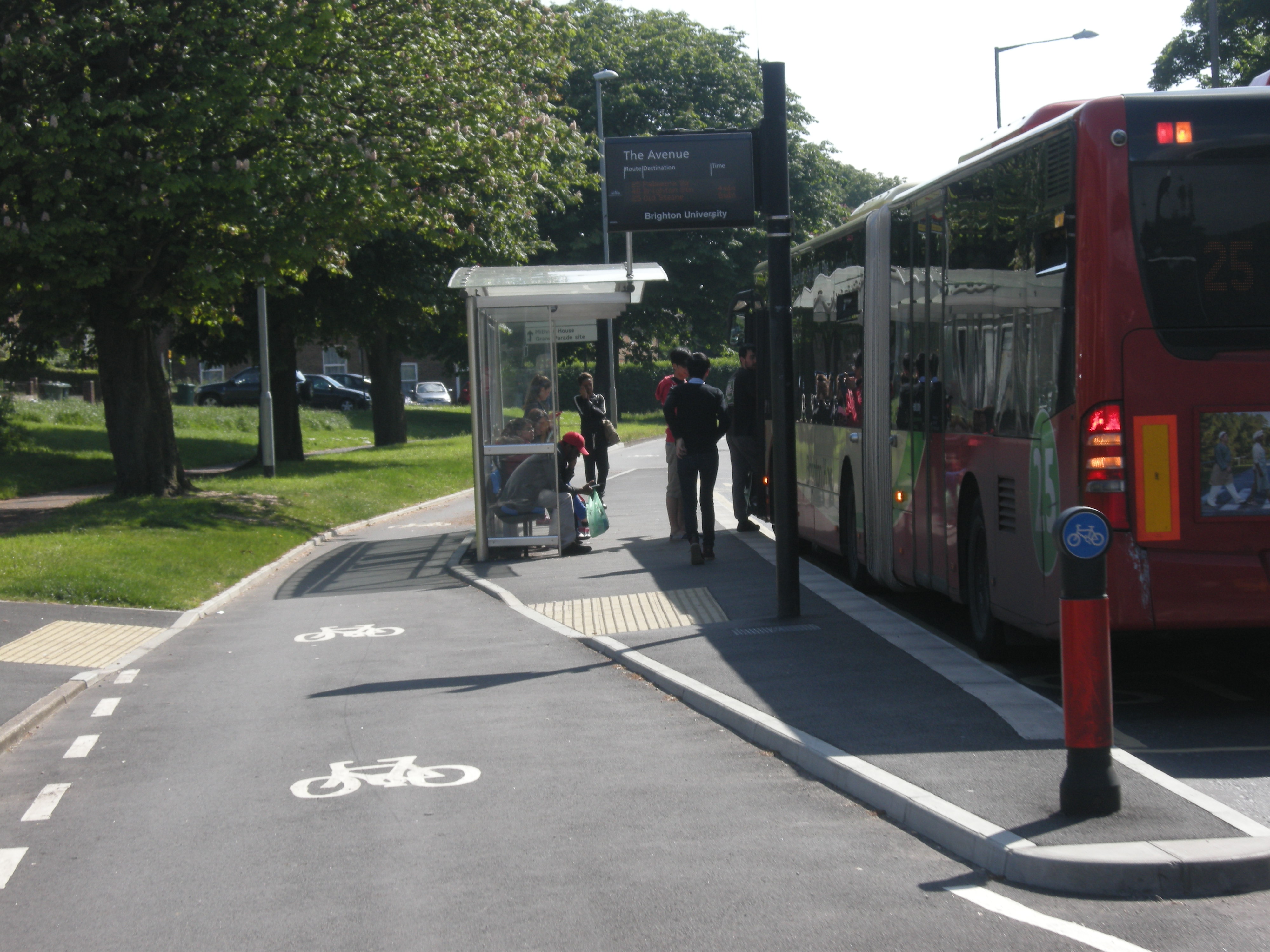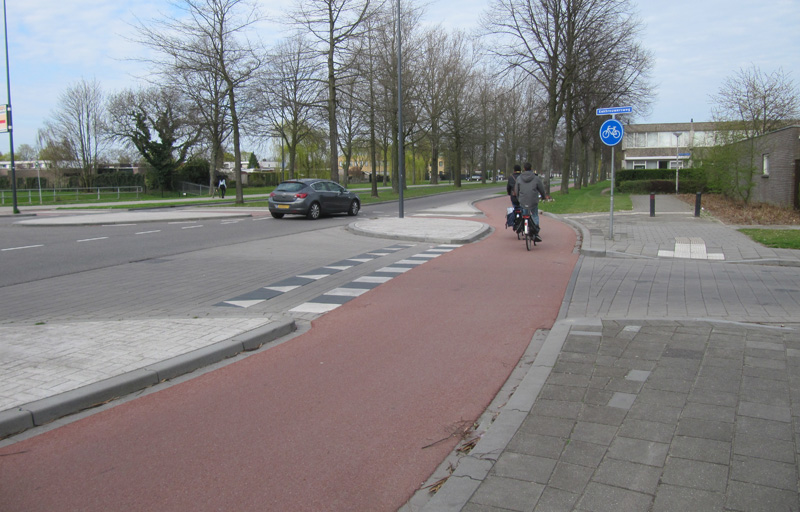This blog is my response to the above consultation as referenced here:
I also welcome, in principle, the concept of continuing the protected cycle path in proximity to bus-stops. Often with poor quality implementations, cycle lanes give up at "difficult" points like this, thus forcing cycles into conflict with buses; two forms of transport that are least suited to mixing.
To reiterate, I approve of these measures - EDC have the opportunity here to provide good quality facilities that outstrip the ambition of neighbouring councils. With all that said, I have some comments that I'd like you to consider:
This potential for conflict should not be necessary with a well-designed scheme. Much better examples exist in the UK already, specifically in Brighton (see below):
http://www.cycling-embassy.org.uk/photos/good-cycling-facility-of-the-week/good-cycling-facility-of-the-week-5th-june-2014
Firstly,
I have to commend EDC for their vision. I am encouraged that there
appears to be a recognition that separating modes of travel is vital to
increasing the number of people cycling, by improving both actual safety
and (crucially) a subject sense of safety - the latter is
particularly important for encouraging demographic groups such as
children and the elderly who are currently excluded from cycling through
fear of hostile road conditions.
I'm pleased that priority for the cycle path will be given over minor side roads - this is particularly important as it:
I'm pleased that priority for the cycle path will be given over minor side roads - this is particularly important as it:
- Signals that cycling is considered a serious form of transport, rather than something associated with leisure
- Facilitates journeys along the path by minimising interruptions by give ways and junctions - cycling is most suited to continuous travel conditions at steady speeds
- Will encourage potential users onto the facility who, under normal circumstances, would forgo the use of cycle infrastructure which typically impede progress
I also welcome, in principle, the concept of continuing the protected cycle path in proximity to bus-stops. Often with poor quality implementations, cycle lanes give up at "difficult" points like this, thus forcing cycles into conflict with buses; two forms of transport that are least suited to mixing.
To reiterate, I approve of these measures - EDC have the opportunity here to provide good quality facilities that outstrip the ambition of neighbouring councils. With all that said, I have some comments that I'd like you to consider:
1. Bus-stop by-pass
The Royal College Street bus-stop cited in your document is an inferior example to follow. It puts people on cycles into direct conflict with people boarding or alighting buses. There is only a narrow strip on which to stand and the bus shelter is on the wrong side of the cycle path. As such, it has been necessary to force cycles to give way, thus impeding progress. In addition, elderly, disabled or passengers with pushchairs may feel uncomfortable crossing the path at this point, even if they have notional priority.This potential for conflict should not be necessary with a well-designed scheme. Much better examples exist in the UK already, specifically in Brighton (see below):
 |
| A Bus-stop bypass in Brighton with plenty of space for passengers - first class |
As you can see, the (wide) cycle path diverts
around the rear of the bus-stop and the shelter. Pedestrians will still
have to cross the path, but the crossing takes places away from the
actual stop itself, thus completely avoiding the potential for conflict
with passengers on a recently arrived bus. The effect is similar in
function to existing unmarked road crossings with pedestrian refuges -
an arrangement most users will already be readily familiar with.
This sort of facility is very common in the Netherlands. For further continental examples, please follow this link:
http://www.aviewfromthecyclepath.com/search/label/bus%20stop%20bypass
http://www.aviewfromthecyclepath.com/search/label/bus%20stop%20bypass
I
appreciate that it may be that lack of space behind the bus-stop might
be cited as justification for your approach here, but it would be
worthwhile considering narrowing the road and pushing the bus-stop
further into the lane, as is commonplace for other crossing points. Alternatively, it might be necessary to relocate the bus-stop to a more suitable location. It also might be easier to implement a scheme on a uni-directional path (see point 3).
2. Junctions with Minor Roads
As I stated above, giving cycles priority over minor side roads is a major step forward. However, the design used is sub-optimal.
Typical
junction treatments where cycle paths cross minor roads in the
Netherlands have the cycle (and pedestrian) path divert slighty in order
that they cross slightly into the minor road. This means that there is
sufficient space for vehicles turning in and out of the road to wait
whilst giving way:

For right turning vehicles, this helps in keeping the main carriageway clear and thus removes the requirement for a right-turn waiting lane (as per QCC2). Secondly, vehicles make the turn manoeuvre in two distinct movements - this means that the driver does not have to wait for clear oncoming traffic as well as a clear junction to cross the carriageway. Thirdly, it means that the driver is facing the cycle path at right angles, providing better lines of sight between driver and cyclist or pedestrian and hence minimising the potential for error.

For right turning vehicles, this helps in keeping the main carriageway clear and thus removes the requirement for a right-turn waiting lane (as per QCC2). Secondly, vehicles make the turn manoeuvre in two distinct movements - this means that the driver does not have to wait for clear oncoming traffic as well as a clear junction to cross the carriageway. Thirdly, it means that the driver is facing the cycle path at right angles, providing better lines of sight between driver and cyclist or pedestrian and hence minimising the potential for error.
See the following links for further examples:
https://departmentfortransport.wordpress.com/2012/08/21/continuous-paths-across-minor-junctions/
https://departmentfortransport.wordpress.com/2012/08/21/continuous-paths-across-minor-junctions/
3. Cycle Paths: Bi-directional vs. Uni-directiona
It
would be better if a way could be found to keep the cycle path on one
side of the road for the whole length of the facility. Indeed, it would
be even more worthwhile considering implementing two uni-directional
paths on both sides of the road, rather than a single bi-directional
path which switches sides. The reasons as three-fold:
On that note, the recommended width of paths is as follows (although width recommendations vary with the volume of cycle traffic) - note both below require a 50cm margin between the path and the road:
 (note that is bi-directional path in the picture above).
(note that is bi-directional path in the picture above).
- It is a more natural arrangement, particularly where the path isn't continuous and cycles are coming from roads which don't have separated paths.
- Crossing the road is inefficient and inconvenient - this will be a particularly acute problem if the phases of the crossing aren't optimised to favour cyclists and pedestrians
- Width - if the path is heavily used in both directions, congestion could become a problem as there isn't sufficient space to over-take slower-moving riders
On that note, the recommended width of paths is as follows (although width recommendations vary with the volume of cycle traffic) - note both below require a 50cm margin between the path and the road:
- Uni-directional path - 2m
- Bi-directional path - 3.5-4m

4. Shared Use and The Roundabout
I can see why this method has been chosen for the top part of the route
- it allows users travelling along Main Street to bypass the roundabout entirely. But I can't stress this point enough: shared use paths
represent poor quality cycle infrastructure which benefits no-one other
than motor vehicles, except perhaps where pedestrian use of the path is
negligible in the first place. All shared use paths do is put
pedestrians into direct conflict with cycles - the reason why bikes were
banned from the pavements in the first place. This creates ill-will
between the two user groups, whilst impeding the natural progress of
quicker, more nimble bike users (although, the priority at minor roads
mitigates this to a degree).
It also avoids dealing
with the most problematic element: the roundabout itself. There are ways to upgrade roundabouts to make them safely navigable by bike, particularly ones as large and with
as much unused space as this example. Upgrading the roundabout will also extend the
usefulness of the facility for those travelling further north along the
A81 Glasgow Road. Southbound riders coming from that direction would
have difficulty gaining access to the path as a result.
The following video illustrates a number of potential solutions for the roundabout. I would strongly advise giving it a watch:
Alternatively there are a number of examples discussed here:
http://www.aviewfromthecyclepath.com/search/label/roundabouts
http://www.aviewfromthecyclepath.com/search/label/roundabouts
No comments:
Post a Comment